Long-Term Causes of WWII
There are up to half a dozen long-term causes of the bloodiest military conflict in history.
The Treaty of Versailles (1919)
The Treaty of Versailles was an important aspect of the Paris Peace Conference (1919-1920) which concluded WWI. This agreement dictated the terms of the postwar settlement.
Historians believe that these terms were too harsh for Germany and set in motion the events that led to the Second World War.
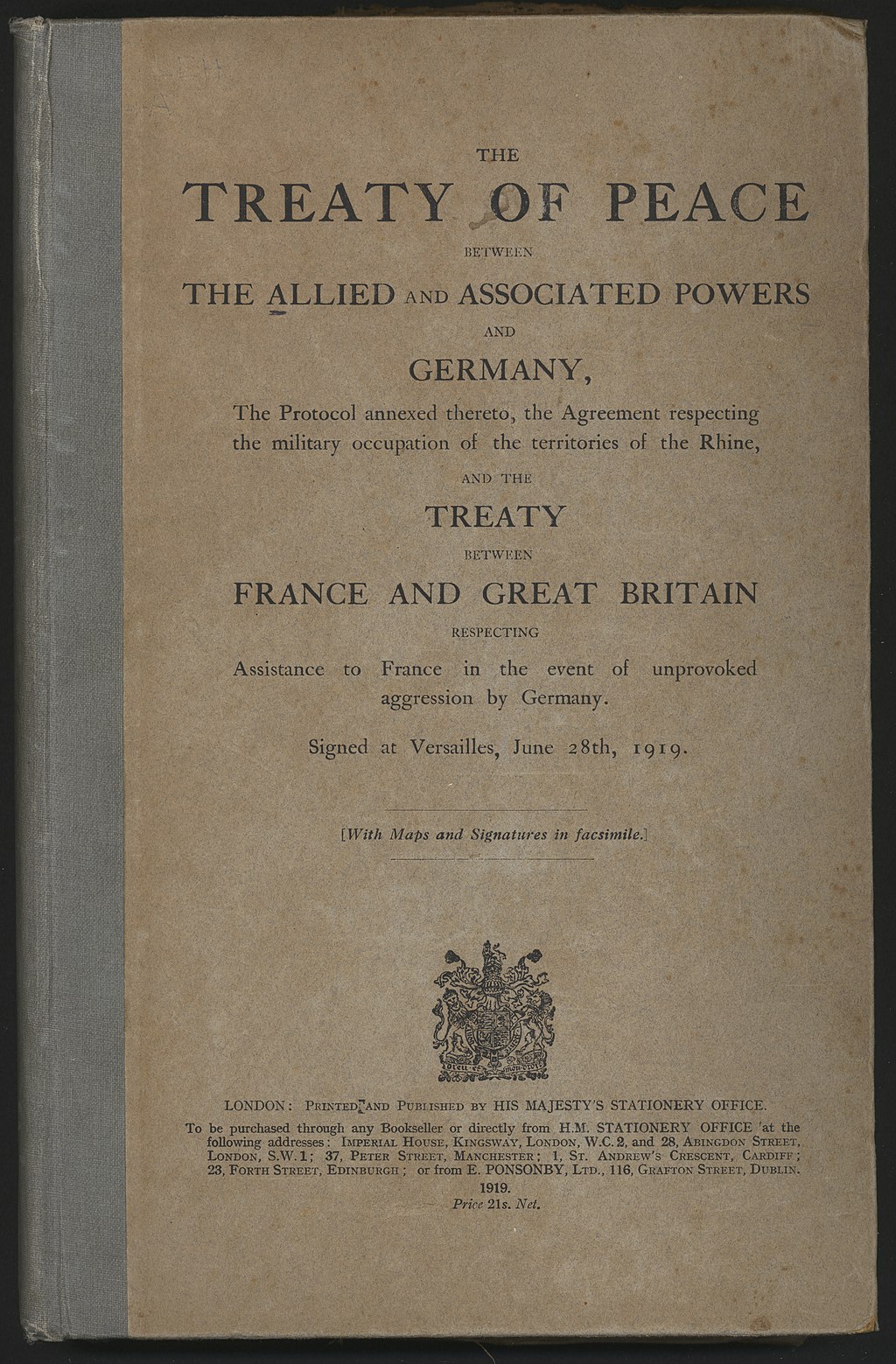
Treaty of Versailles cover, ca. June 28th, 1919. Source: Auckland War Memorial Museum, Wikipedia Commons (public domain).
The scar WWI left on Europe was deep and bloody, the resentment animated the term of surrender and reconciliation. The treaty was between the victors of this conflict, Britain, the United States, Japan, and France, and the vanquished, Germany. Neither Germany nor its wartime allies Hungary and Austria–the Central Powers–were allowed to define the contents of the treaty. The victors punished Germany by blaming it for the war. As a result, Germany, known as the Weimar Republic from 1918-1933, was ordered to:
- reduce its weapons stockpiles and the size of its armed forces in a process of demilitarization;
- pay reparations to the affected countries;
- give up several territories to France, Belgium, Poland, and Czechoslovakia, as well as its colonies abroad.
In addition, Austria lost such territories as Sudetenland to Czechoslovakia through another postwar agreement, the Treaty of Saint Germain (1919), which became an important lead-up to the Second World War.
The Inter-Allied Military Commission of Control oversaw Germany’s adherence to the terms of demilitarization, for instance, limiting its army to 100,000 men, and reducing weapons ownership and the import and export of materiel.
Materiel is a term used to describe military equipment, supplies, and weapons.
Furthermore, border disputes persisted. According to Germany, millions of Germans were now stranded in foreign countries because of the Versailles Treaty. The Pact of Locarno (1925) was supposed to confirm the German border with France and Belgium, respectively, but it did not help in the long term.
Economic Causes of WWII
The Weimar Republic was in a terrible economic state and experienced hyperinflation of its currency in the early 1920s. The American-led Dawes and Young Plans in 1924 and 1929, respectively, were meant to relieve some of the economic pain through loans and other financial mechanisms.
Hyperinflation is a rapid devaluation of a currency that is accompanied by rapidly rising prices.
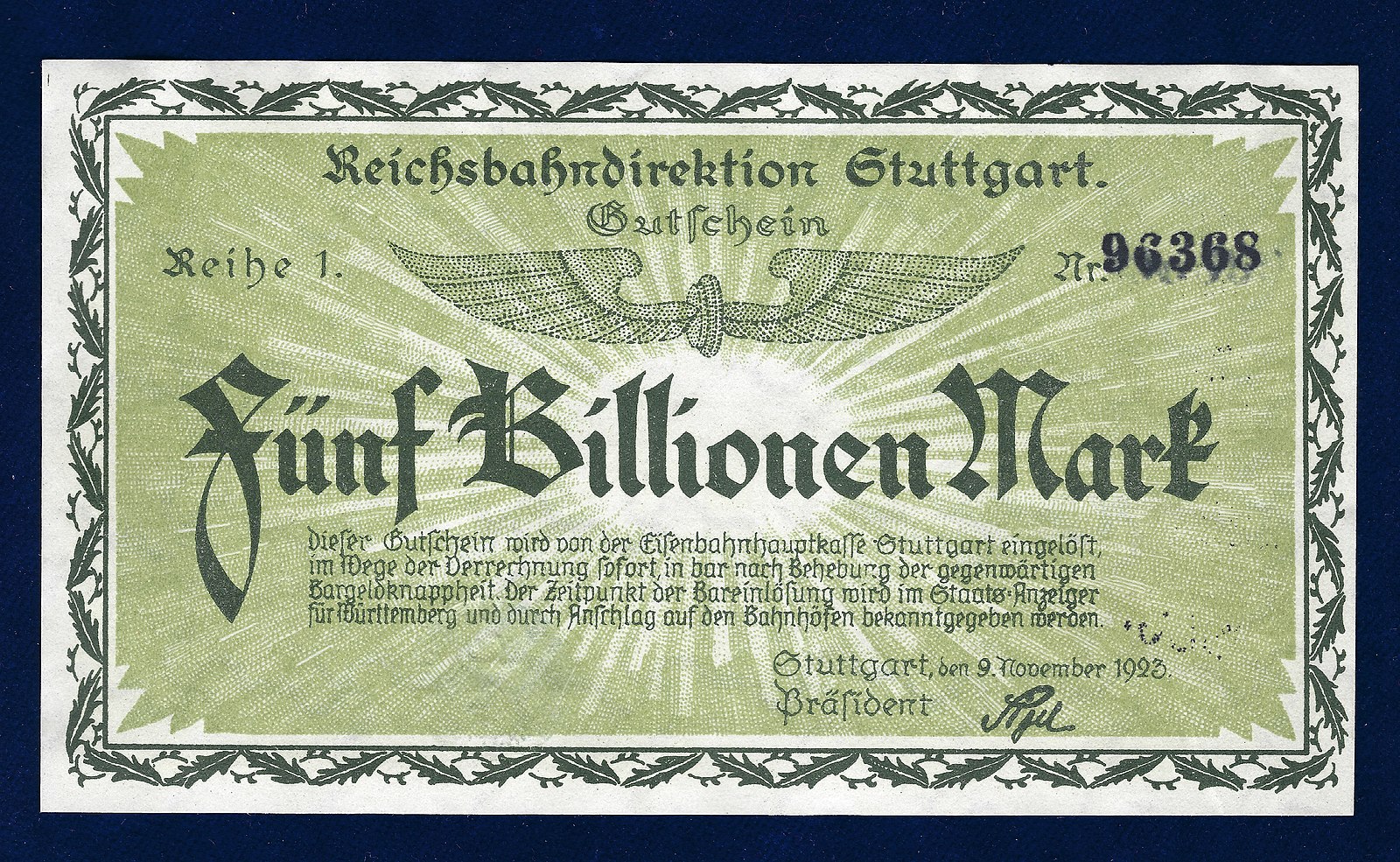
German Railways Banknote, 5 billion marks during the hyperinflation period in 1923. Source: Wikipedia Commons (public domain).
One striking example is the devaluation of the German mark. A loaf of bread went from costing 250 marks in early 1923 to 200,000 million marks by the end of the same year.
The Great Depression arrived with the U.S. stock market crash of 1929. It led to joblessness, homelessness, and hunger for the public, along with bank failures and a significant decline in the gross national product.
Gross national product (GNP) is the combined total value of products manufactured and services offered in a country in a single year.
Germany began to slowly recover by the time Adolf Hitler came to power in 1933, and the country became known as the Third Reich. However, the populist support of the Nazi (National Socialist) Party came from the preceding economic conditions.
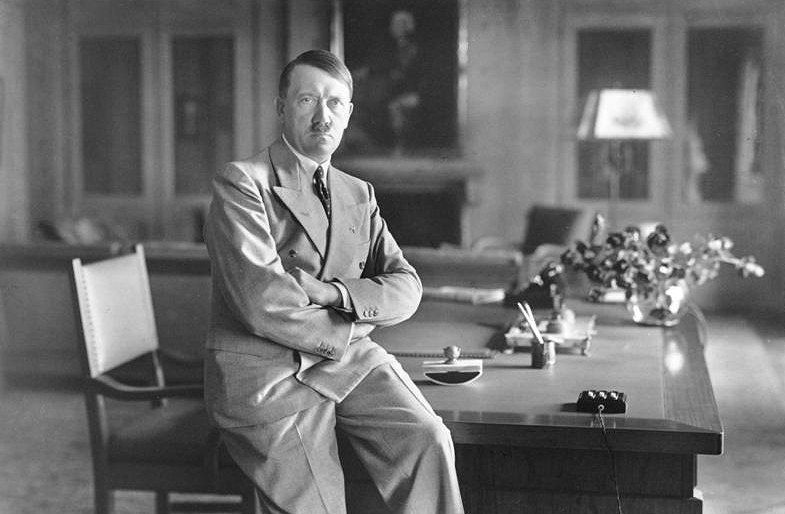
Adolf Hitler, 1936. Source: Bundesarchiv, Bild 146-1990-048-29A / CC-BY-SA 3.0, Wikipedia Commons.
Failure of the League of Nations
In addition to the Treaty of Versailles, the League of Nations was the second important result of the Paris Peace Conference. Representatives of more than 30 countries worked to establish the League—an international organization meant to foster global peace.
In decade later, 15 countries, followed by dozens of others, signed the Kellogg-Briand Pact (1928):
- The U.S.
- Germany
- Britain
- France
- Japan
This agreement also sought to prevent war. However, the Kellogg-Briand Pact lacked enforcement mechanisms. In 1931, Japan attacked China's Manchuria. The League of Nations failed to adequately punish Japan, and the Kellogg-Briand Pact was ambiguous. Several other incidents, such as Italy's invasion of Ethiopia (1935), discredited the international legal system in the 1930s and set the world on a path to war.
Failure of International Agreements
There were many agreements signed between different countries in the interwar period. Some agreements reinforced the Treaty of Versailles like the Locarno Pact. Others sought to foster peace in general, such as the Kellogg-Briand Pact. Other agreements with Germany, like the non-aggression pacts, sought to prevent war between the given signatories, such as the Molotov-Ribbentrop Pact between the Soviet Union and Germany. Finally, the ineffective appeasement of the Munich Agreement ceded territories to Hitler—Sudetenland in Czechoslovakia—to prevent greater war.
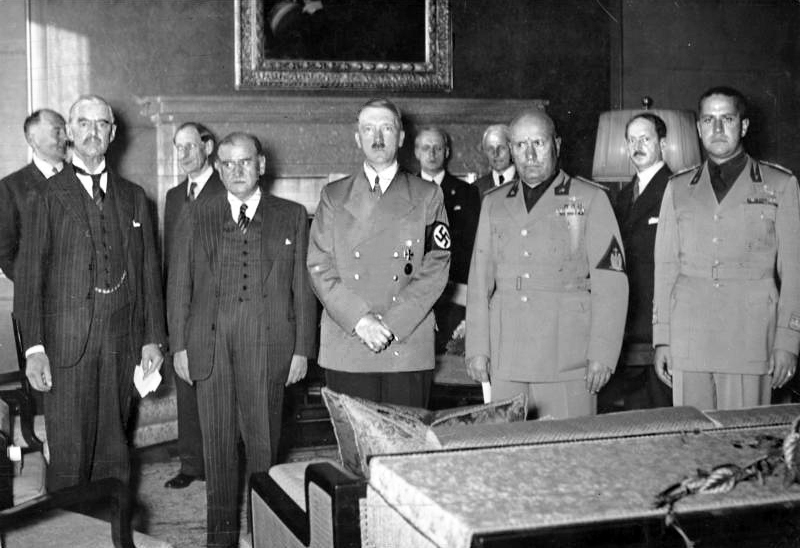
Munich Agreement signatories, (L-R) Britain’s Chamberlain, France’s Daladier, Germany’s Hitler, Italy’s Mussolini and Ciano, September 1938. Source: Bundesarchiv, Bild 183-R69173 / CC-BY-SA 3.0, Wikipedia Commons.
| Date | Agreement |
| December 1, 1925 | Locarno Pact between France, Belgium, Germany, Italy, and Britain about the shared borders of Germany, Belgium, and France. |
| August 27, 1928 | Kellogg-Briand Pact, between 15 powers. |
June 7, 1933 | Four-Power Pact featuring Germany, Italy, France, and Britain. |
January 26, 1934 | German-Polish Declaration of Non-Aggression. |
October 23, 1936 | Italo-German Protocol. |
September 30, 1938 | Munich Agreement featuring Britain, Germany, Italy, and France. |
June 7, 1939 | German-Estonian and German-Latvian Non-Aggression Pacts. |
August 23, 1939 | Molotov-Ribbentrop Pact featuring Germany and the Soviet Union. |
September 27, 1940 | Tripartite Pact (Berlin Pact) featuring Germany, Japan, and Italy. |
German Nazism, Japanese Imperialism, and Militarism
In Europe, Nazi ideology under Adolf Hitler featured a racialist, supremacist hierarchy, in which ethnic Germans were at the top, and others, like Jews and Slavs, were considered inferior (Untermenschen). The Nazis also subscribed to the concept of Lebensraum, "living space." They believed that they were entitled to acquire Slavic lands for ethnic Germans. This idea was one of the motivations for the invasion of the Soviet Union in June 1941.
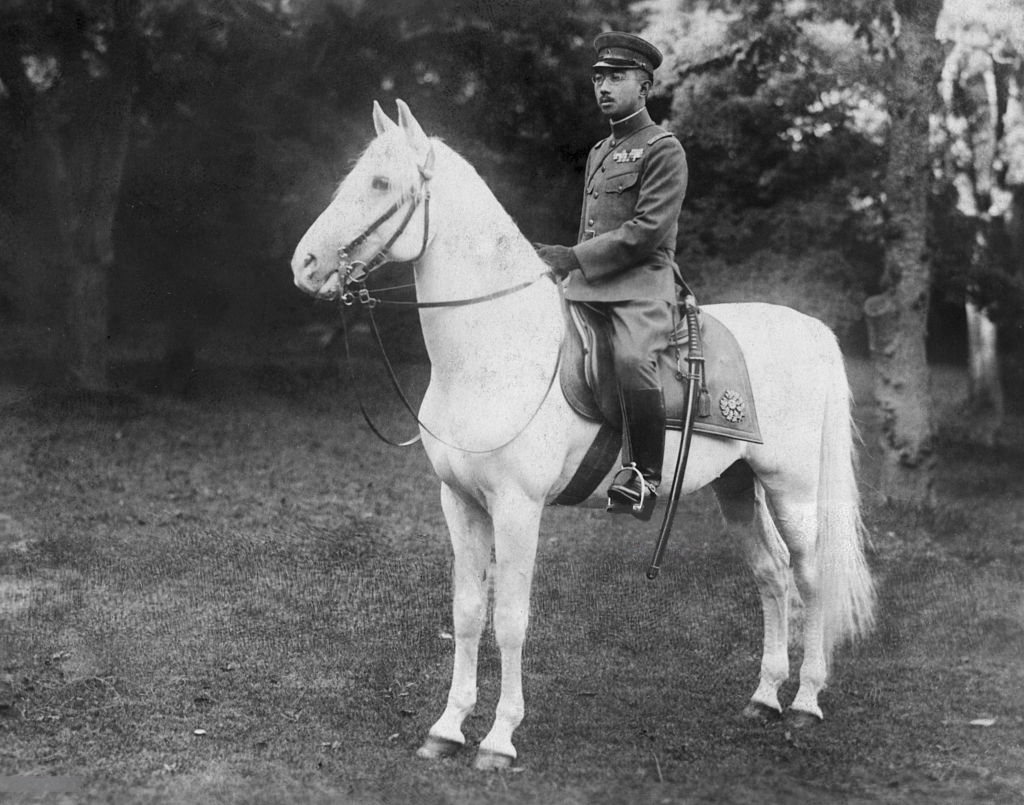
Emperor Hirohito channeling militarist aesthetics on his favorite white horse: Shirayuki (White Snow), 1935. Source: Osaka Asahi Shimbun, Wikipedia Commons (public domain).
In Asia, the Japanese empire under Emperor Hirohito invaded other countries from 1931-1945, having already annexed Korea in 1910. Japan invaded China's Manchuria in 1931, the rest of China in 1937, and other countries in Southeast Asia, such as Vietnam during World War II. Japan called its empire the Greater East Asia Co-Prosperity Sphere. In reality, Japan extracted the resources it needed from its colonies.
Both Germany and Japan subscribed to militarism. Militarists believe that the army is the backbone of the state, and military leaders often hold top government positions.
Short-Term Causes of WWII
The short-term causes of World War II involved the aggressive behavior of Japan, Italy, and Germany toward many nations.
Check out the following timeline of the short-term causes of WWII:
| Date | Event | Description |
| 1931 | Mukden Incident | Japan created a pretext to invade China's Manchuria in September 1935 contrary to the Kellogg-Briand Pact and the League of Nations arbitration. |
| 1935 | Abyssinian Crisis | The League of Nations was unable to resolve a brewing conflict in North Africa. Italy, which had African colonies such as Eritrea, invaded Ethiopia (Abyssinia) in October 1935. |
| 1936 | German troops in the Rhineland | Hitler put troops in the Rhineland region, which contradicted the Treaty of Versailles. |
| 1937 | Second Sino-Japanese War | The Second Sino-Japanese War began in July 1937 between Japan and China. It became part of the Pacific theater in World War II. |
| 1938 | Annexation of Austria (Anschluss) | In March 1938, Hitler annexed Austria and absorbed it into the Third Reich. |
| 1938 | Germany annexes Sudetenland | In October 1938, Germany annexed Sudetenland (Czechoslovakia) followed by Polish and Hungarian annexation of other parts of that country. Germany invaded the Czech parts of Czechoslovakia in March 1939. |
| 1939 | Germany's invasion of Poland | On September 1, 1939, Germany invaded Poland. France and Britain declared war on Germany, so World War II officially began. |
Short-Term Causes of WWII: German Invasion of Poland
Poland and Hungary invaded Czechoslovakia after Germany annexed Sudetenland in that country in October 1938. However, these events did not prevent Poland from being invaded by Germany on September 1, 1939. That date marked the start of the Second World War.
Two days later, both France and Britain declared war on Germany. On September 17, the Soviet Union also entered Poland in an attempt to push the conflict away from the Soviet borders. This attempt to avoid war also failed when Germany invaded the Soviet Union on June 22, 1941.
By the start of World War II in Europe, the Second Sino-Japanese War had been raging in Asia since 1937. The two conflicts turned into one with Japan's strike on America's Pearl Harbor on December 7, 1941, making the war truly global.













